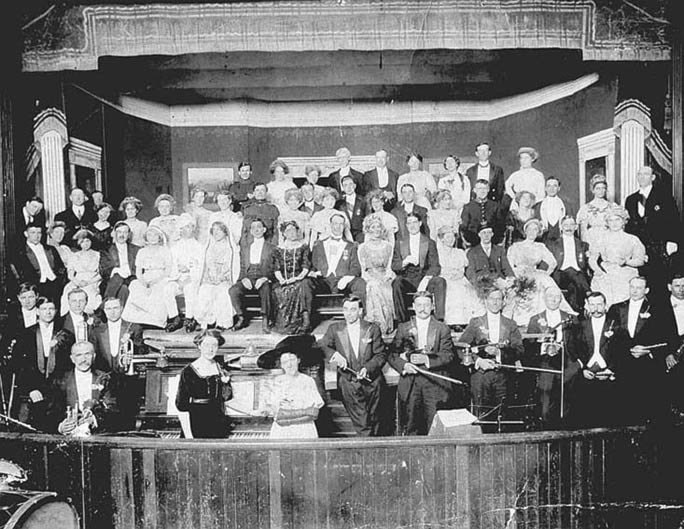Jim Cameron
The Cranbrook Community Theatre Society celebrated its 50th anniversary this year, or, to be more accurate, neglected to celebrate its 50th anniversary this year. An amateur theatre group staying in business for 50 years is quite an achievement.
The Community Theatre did celebrate its 40th anniversary this year as stewards, on behalf of the city, of the former Masonic Temple, now "The Studio". An amateur theatre group in the same place for 40 years is nothing short of miraculous.
A few years ago the group celebrated the 100th anniversary of the construction of the grand old building. Perhaps there were just too many anniversaries on top of each other to worry about the latest one. And besides, they were busy doing things, like producing plays, which, as we know, they have done for 50 straight years.
That is not to say that community theatre in Cranbrook began only 50 years ago. In fact, this year marks the 111th anniversary of amateur theatre in Cranbrook.
The first live theatre performance in Cranbrook took place in April, 1898, but that was a professional touring company — or at least something along those lines — and therefore doesn't count.
There were plenty of professional theatre troupes travelling through in the early days, performing in whatever venue they could find; often empty stores or meeting halls. The opening of the Wentworth (originally Forrest) Opera House, adjacent to the Wentworth (originally Forrest) Hotel, in 1898, allowed performers a slightly upscale venue in which to display their talents.
As for amateur theatre, aside from occasional one-off performances, essentially talent shows, there appears to have been nothing in the way of theatrical undertakings until the spring of 1903, and for that we might thank the town of Pincher Creek. In May, 1902, the residents of that little community — about 400 people at the time — decided to mount a production of Gilbert and Sullivan's "Pirates of Penzance" and, with a cast of 40, take it on the road — or rather, rails — to Cranbrook, Fernie and Nelson. Pre-sales looked good but severe flooding in the Crows Nest Pass halted all traffic and forced the cancellation of the tour.
It might well be argued that, therefore, the following spring, when a local production of "Pirates of Penzance" appeared for four consecutive nights, Cranbrook was merely borrowing a page from a Pincher Creek script. Nonetheless, it was the first actual, amateur, theatrical production in Cranbrook's history and, if the reviews are to be believed (and they often are, of course) it wasn't half bad.
In honour of the show, the stage of the Wentworth Opera House was enlarged by 15 feet and the seating raised to allow for better sightlines, thereby improving the theatre experience for years to come.
Featuring a cast and chorus of mostly local players, the play was directed and produced by Mr. William Mackenzie, who may have been brought in for that express purpose. Both he and his wife starred in the operetta and then likely moved on, for they do not seem to appear again in the Cranbrook theatre scene.
The following year saw another Gilbert & Sullivan production mounted in the Wentworth Opera House, This time it was "The HMS Pinafore", which took to the stage on five consecutive nights, with the exception of the third night when the presentation was cut short by a lighting failure. The first two nights were crowded, the remaining two not so much. Such is theatre.
Things went dormant, acting-wise, for the next few years, although the Epworth (Methodist) League did perform some Shakespeare on-site for the men of the Robinson-McKenzie logging company in 1908, which probably counts for something, somewhere. They showed up again at the local gymnasium in 1910, no doubt determined to bring high drama to the unwashed masses.
Obviously it took some time for the masses to wash up because the next local theatrical production was seven years after the previous one. Of course, other communities were treading the boards as well. The Creston Amateur Dramatic Society brought a show to Cranbrook in March, 1910; a "genuinely funny comedy" which played to a large audience. The Creston troupe promised to return the following year but never did. Such is theatre.
It may be said that "The Geisha", performed in March, 1911, in the Auditorium that once stood in the place of the Armond Theatre, marked the Golden Age of local amateur theatre, an age that has miraculously continued to the present day. The Geisha featured a cast, crew and ten-piece orchestra made up entirely of local amateurs, all members of the newly formed Cranbrook Amateur Operatic Society, including such names as Kennedy, Drummond, Service, Wilson, Darling, Leitch, Worthington, Manning, Wallinger, Raworth and at least three musicians named Thompson with or without the p, names that would continue to appear until such time as younger players likely came along and booted them out. Such is theatre.
As far as theatre groups go; Rossland, Summerland, Yellow Point, Vancouver, Kelowna, New Westminster, Victoria and Langham, among others, all claim to be "one of the oldest theatre companies in B.C.", which must mean that they all are. Still, Cranbrook can trace its amateur theatre roots back for well over a century, and that's saying something.
And, just for the record, the present-day Cranbrook Community Theatre was formed on the evening of February 5, 1964, just in time for their first production of "Jack and the Beanstalk." The executive consisted of Flo Downey, vice-president; Lucille Misisco, treasurer; Betty Neilson and Joan Abbott, publicity and, perhaps not surprisingly, Bud Abbott, president.
